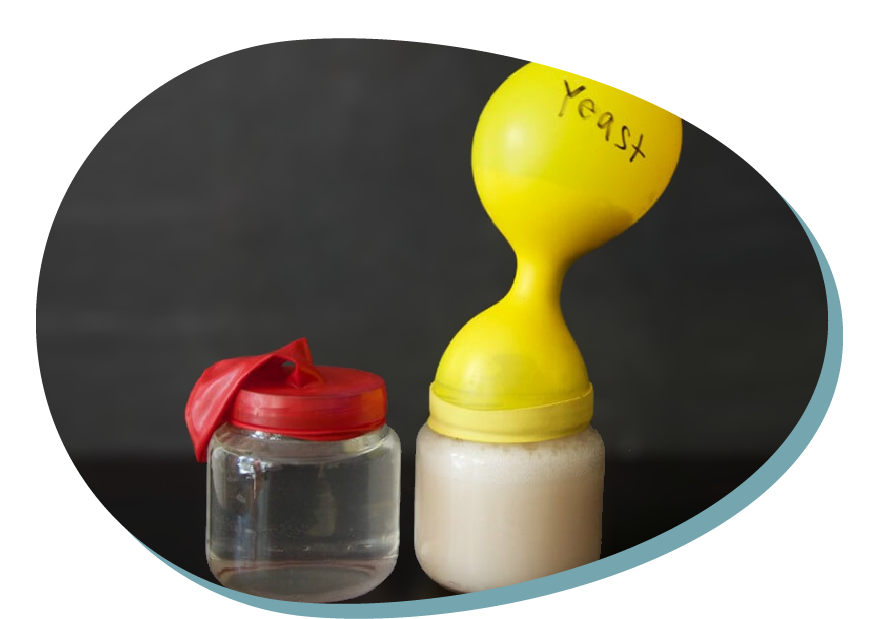How yeast works? The Science Behind Yeast
Type of resource: Web page
Web address https://www.playdoughtoplato.com/the-science-of-yeast/
Language: English
Description
With just a few household items, we can see how the tiny fungi work to create those pockets of air that make bread so delightfully squishy.
Scientific concept introduced
Reactions, microorganisms, growth, gas production, fermentation.
Creative and critical thinking
Inductive thinking
Ability to observe and relate phenomena.
Mathematical reasoning
Measuring (keeping the proportions)
Counting (time in an analogic timer)
Scientific thinking
Observe
Ask questions
Analyze facts
Obtain conclusions
Learning how to learn
Active learning through experimentation and manipulation of different substances.
Additional
Learn to be cautious when handling substances that may react.
How yeast works? The Science Behind Yeast
Overall aims
To develop the ability to observe and discover
To enhance the interest of experimenting and manipulating with different objects and materials.
To improve the ability to relate phenomena
To know the existence of small living beings that we can’t see
To demonstrate the presence of gases
Vocabulary – keywords should be understood
Little fungi, yeast, reactions, growth, sugar, gases, water, balloons, bottles, air, explosion, fermentation, bread cooking
Expected learning outcomes (operational aims)
To compare situations and recognize different elements
To explain a biological reaction
To carry out an experiment
To discover the existence of microorganisms
To recognize the presence of gas
STEM skills – to which the learning unit is related to
Asking questions
Analyzing and solving problems
Designing experiments
Drawing conclusions based on results
Motivation to learn and engage
Self-discipline and self-regulated learning (cognitive autonomy)
Relate facts and phenomena
Teaching methodologies/activity outline
With just a few household items, we can see how the tiny fungi works to create those pockets of air that make bread so delightfully squishy:
1 – Lest go to see what we need to start the experiment:
Give them the following elements: 2 bottles, 2 balloons, active dry yeast, a big glass of warm water, and a spoonful of sugar.
2 – Prepare and develop the experiment:
Students may prepare the two bottles with a little bit of warm water with sugar, then, they must add the yeast in one of the bottles and stir. In the other, they do not add it as a control. Finally, they should place the balloon on the neck of the bottle blocking the exit.
3 – Results of the experiment:
Wait a few minutes and observe what is happening.
Ask them what they think is going to happen. They should predict the balloon with yeast will inflate and get big the balloon. They also should think about why the control with only water and sugar do not inflate the balloon.
When they put their ear on the balloon, they can hear the bubbles as they formed and grew out of the jar and into the balloon. Soon the balloon will get so big that you should be worried if it explodes.
4 – Conclusion:
As the yeast eats the sugar, it releases a gas called carbon dioxide. The gas fills the bottle and, as more and more gas are produced, it fills the balloon.
In bread dough, the carbon dioxide from the yeast gets trapped in the gluten from the flour. The yeast dies in the hot oven leaving and the gluten solidifies leaving us with wonderfully soft bread!
Assessment of learning
Initial evaluation
Get to know the previous knowledge about fungi, microorganisms growth, gases, biological reactions, cooking fermentation procedures…
Continued evaluation
Think, create, elaborate explanations of the real phenomena.
Observe and explore the immediate, natural and physical environment, with an attitude of curiosity.
Use the oral language, gesture and images to express ideas. Listen and participate actively in regular situations.
Manifesting the necessary abilities to be able to listen, observe and interpret.
Final evaluation
To evaluate the learning objectives, use the chart in which the more important elements will be highlighted.
Equipment and materials to be used in learning unit (tools, ingredients etc)
– 2 bottles
– 2 balloons
– active dry yeast
– a big glass of warm water
– a spoonful of sugar.
Kind of setting
Preschool room
References – source
How yeast works? The Science Behind Yeast
1. Usefulness for STEM education – integrating content of different disciplines
Cross-curricular character of the resource

The range of S-T-E-M subjects included

The presentation of possibilities of including artistic activities (STEAM approach)

2. Expected learning outcomes
Consistency (links) with preschool core curriculum

Communicativeness of description

3. Methodology of teaching
Clarity, communicativeness of instructions for teachers

Meaningful learning – using practical life problems

Original idea

The level of ease in implementing the methodology to preschool age children

The level of ease in preparing necessary ingredients, materials and equipment needed

4. Sustainability
Ecological characteristics of materials/ results

Supporting healthy eating habits

Low ecological footprint

Possibilities of inclusion (respecting cultural diversity and food intolerances)

5. Class management
Using differentiated forms of work – individual, team work etc.

Individual work

Team work

Whole group
6. Time management

Short activity (10-15 minutes)

Medium activity (20-30 minutes)

Long activity (1 hour or more)

Very long activity (1 day or more)
PDF: https://www.printfriendly.com/p/g/ESttHU

